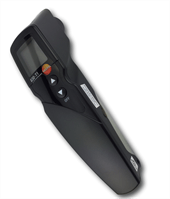Infrared Thermometers - What Factors must you consider?
Infrared Thermometers - What Factors must you consider? |
 | Infrared thermometers are popular temperature measuring devices as they are easy to use, take non-contact measurements (so there’s no risk of contamination), are quick to take a measurement and they can measure temperatures from a distance. This makes them popular for food and warehousing applications, as well as manufacturing, electrical and mechanical applications.
There are a number of factors that must be considered when choosing an infrared thermometer and these are listed below. | |
| Target temperature What temperature range do you need to measure? Some infrared thermometers are only suitable for low temperatures, some are suitable for mid-range temperatures, and some are suitable for very high temperatures. For example the IC7218TM is only suitable for temperatures up to 110C, the Testo 0560-8311 (pictured) can measure up to 400C, whereas the IC7226TM is suitable for temperatures up to 1000C. Target material Products like wood, plastic, glass and paint tend to work well with infrared thermometers as they have high emissivity values (around 0.90 to 0.95). Emissivity is a measure of the ability of a material to emit energy as thermal radiation and ranges on a scale from 0 to 1. A lot of infrared thermometers are set as default to an emissivity of 0.95 and some are fixed at this value, but some will allow you to adjust this value. Ultimately the emissivity setting on the thermometer should match the emissivity value of the material you are measuring. Metals, particularly unoxidised metals, tend to have low emissivity values, which can make measurements tricky and you may be better of considering a contact thermometer for these applications. Target size and the distance to the target The size of the target and the distance you wish to measure from are very important things to consider when choosing an infrared thermometer. You will often see a distance to spot ratio (D:S) listed on a product. This is a ratio of the distance to the object and the diameter of the measurement area. For example, the 0560-8311 IR thermometer (pictured) has a D:S ratio of 10:1 so when measuring an object 1m away it will average the temperature over a 10cm diameter area. Larger spot ratios such as 30:1 (in the IC7226TM) or 50:1 (in the KIRAY300) mean that you can measure smaller areas from further away. Still not sure about what you need? Give one of our scientists a call on 1300 737 871 or email [email protected] | ||
See our other newsletter articles here!
Contact our expert scientists now to get the right meter or data logger to suit your needs and discuss your project.
Phone: 1300 737 871
Email: [email protected]
